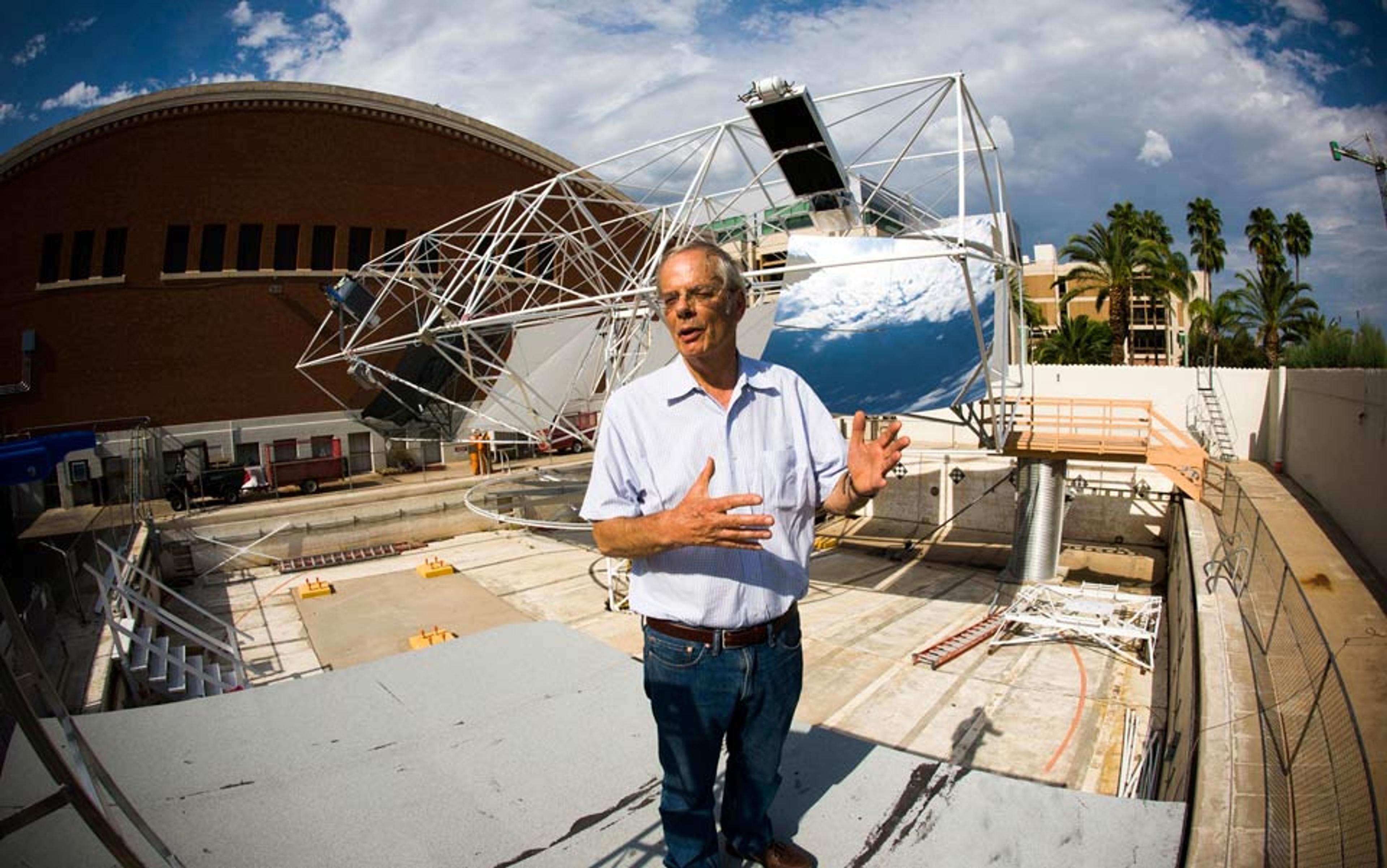At a small conference in Germany last May, I found myself chuckling at the inability of the meeting organisers to control the room’s electronic blinds. It’s always fun when automated technology gets the better of its human masters, but this particular malfunction had a surreal pertinence. Here was a room full of geoengineering experts, debating technologies to control the climate, all the while failing to keep the early summer sun’s rays away from their PowerPoint presentations. As the blinds clicked and whirred in the background, opening and closing at will, I asked myself: are we really ready to take control of the global thermostat?
Geoengineering, the idea of using large-scale technologies to manipulate the Earth’s temperature in response to climate change, sounds like the premise of a science fiction novel. Nevertheless, it is migrating to the infinitely more unsettling realm of science policy. The notion of a direct intervention in the climate system — by removing carbon dioxide from the atmosphere, or reflecting a small amount of sunlight back out into space — is slowly gaining currency as a ‘Plan B’. The political subtext for all this is the desperation that now permeates behind-the-scenes discourse about climate change. Despite decades of rhetoric about saving the planet, and determined but mostly ineffectual campaigns from civil society, global emissions of carbon dioxide continue to rise.
Officially, climate policy is all about energy efficiency, renewables and nuclear power. Officially, the target of keeping global temperatures within two degrees of the pre-industrial revolution average is still in our sights. But the voices whispering that we might have left it too late are no longer automatically dismissed as heretical. Wouldn’t it be better, they ask, to have at least considered some other options — in case things get really bad?
This is the context in which various scary, implausible or simply bizarre proposals are being put on the table. They range from the relatively mundane (the planting of forests on a grand scale), to the crazy but conceivable (a carbon dioxide removal industry, to capture our emissions and bury them underground), to the barely believable (injecting millions of tiny reflective particles into the stratosphere to reflect sunlight). In fact, the group of technologies awkwardly yoked together under the label ‘geoengineering’ have very little in common beyond their stated purpose: to keep the dangerous effects of climate change at bay.
Monkeying around with the Earth’s systems at a planetary scale obviously presents a number of unknown — and perhaps unknowable — dangers. How might other ecosystems be affected if we start injecting reflective particles into space? What would happen if the carbon dioxide we stored underground were to escape? What if the cure of engineering the climate is worse than the disease? But I think that it is too soon to get worked up about the risks posed by any individual technology. The vast majority of geoengineering ideas will never get off the drawing board. Right now, we should be asking more fundamental questions.
Here is a project that elevates engineers and their political masters to the status of benevolent deities
Geoengineering differs from other approaches to tackling climate change not in the technologies it seeks to deploy but in the assumptions it makes about how we relate to the natural world. Its essence is the idea that it is feasible to control the Earth’s climate. It is a philosophy, then — a philosophy that characterises the problem of climate change as something ‘solvable’ by engineering, rather than a social phenomenon emerging from politics and culture.
Thinking about it in this way — as a set of assumptions about how to tackle climate change rather than a set of technologies — makes it easier to see why the ethical issues embedded in the concept are trickier than any scientific disputes about the side effects of this or that piece of machinery. Here is a project that elevates engineers and their political masters to the status of benevolent deities; a project that requires us to manage a suite of world-shaping technologies over the long haul. Do we have either the desire or the capacity to do that? As the late American climate scientist Stephen Schneider wrote in 2008: ‘Just imagine if we needed to do all this in 1900 and then the rest of 20th-century history unfolded as it actually did!’ In other words, world history is volatile enough even without the question of how to manage the global climate.
Let’s think about how disputes might play out. What if I, as the ruler of a nation beginning to feel the adverse effects of climate change, unilaterally decided to start reflecting sunlight back into space? What if this had the effect of altering the rainfall in your nation? It is not difficult to see how quickly the Cold War logic of imagined threats and counter-threats would creep in to the geopolitics of climate management. The lessons of a film such as Dr Strangelove, or: How I Learned to Stop Worrying and Love the Bomb (1964) could well apply to meteorology as much as they do to nuclear physics.
Even short of provoking military conflict, it is not obvious whose consent should be sought before a government, or even a wealthy individual, decides to embark on ‘Experiment Earth’. What’s more, if you believe, as I do, that the story of climate change is at root one of injustice, it’s even less clear how a high-tech geoengineering industry — inevitably directed by a consortium of wealthy nations — would do anything but exacerbate the division between those who are protected from climate change and those who must suffer its consequences.
These political questions obscure a still deeper issue. If geoengineering involves remaking the global climate, might it also remake the connection between humans and nature? We have always existed in a strange kind of equilibrium with the natural world (whatever that is). Think of urban green spaces: ‘nature’ might be found in them, but we probably wouldn’t call the spaces themselves natural. On the other hand, plenty of human innovations have made their way into our idea of the ‘natural order’. The classic example is smallholder agriculture: what was once (albeit many thousands of years ago) considered the height of mastery over the elements is now an archetypal image of humans living in harmony with their environment. The lines between nature and artifice have always been blurred. They only grow more so as our grand technological narratives advance — as we unlock the code to our own genetic identity or build life from the ‘bottom up’ using nanoscale components.
We can admit all of this and still insist that there are deep-rooted, widely shared intuitions about which elements of the world can be called ‘natural’. It is also clear that a broad range of people share a sense that certain aspects of the natural world lie — or should lie — beyond human influence. When scientists are accused of ‘playing God’, this criticism is as likely to come from an atheist as a religious person. If building life from the bottom up seems, to many, like overstepping the mark, this is not necessarily a theistic judgement. New technologies demand self-reflection about who we are and where we fit into the world. Geoengineering is only the latest idea to prompt that kind of soul-searching. Yet it is different from its predecessors in one important regard: its scope.
Many scientists now believe that the industrial revolution marked the beginning of a new era defined by human dominance over the Earth’s ecosystems — the ‘anthropocene’. More than 20 years ago, the American environmentalist Bill McKibben wrote a book called The End of Nature (1989). He made a devastatingly simple argument: that the natural world could no longer be considered independent from human influence. Choices made by humans were shaping the fundamental nature of the planet itself, not just tinkering around the edges. As McKibben puts it:
By the end of nature I do not mean the end of the world. The rain will still fall and the sun shine, though differently than before. When I say ‘nature’ I mean a certain set of human ideas about the world and our place in it.
Geoengineering represents a very different set of ideas about the world and our place in it. A glance at the popular metaphors beginning to frame the debate leaves little doubt about just what kind of ideas they are. One popular rhetorical approach, for example, is to describe the planet as a patient, in need of treatment. It’s an image that Sir Paul Nurse, the President of the Royal Society, explored in a letter to The Guardian in September 2011:
Geoengineering research can be considered analogous to pharmaceutical research. One would not take a medicine that had not been rigorously tested to make sure that it worked and was safe. But, if there was a risk of disease, one would research possible treatments and, once the effects were established, one would take the medicine if needed and appropriate.
Our ‘sick planet’ is presented as in need of medicine, something that only we, the clever humans, can dispense. Through careful, responsible research, we can determine a cure — never mind the fact that our own consumption is the proximal cause of the disease.
Earlier in his letter, Nurse suggests (plausibly) that there might come a time when we are forced to consider geoengineering. But the claim that we might need geoengineering because we simply can’t rein in our consumption implies a stark and somewhat disturbing truth: the natural world is widely considered more malleable than our own wishes and desires. We even have a name to capture this self-serving inflexibility: human nature.
Long before climate change was even a concept, technocrats, entrepreneurs and ‘rainmakers’ were itching to get their hands on the levers that controlled the heavens
Of course, there is a difference between saying that people can’t change their ways and the argument that we shouldn’t have to. In the US, right-wing climate change denial organisations such as the Heartland Institute have thrown their weight behind geoengineering as a ‘cost-effective’ solution to climate change, flipping neatly from denying that the problem exists to advocating a solution to it. As is often the case with climate change scepticism, rejection of the science appears to be a proxy for dislike of the policy implications. For those who prefer geoengineering to the ‘social engineering’ of behaviour change, controlling the climate seems like a better deal than being controlled themselves.
Then again, the urge to control the weather runs deeply in human societies, as the American historian of science James Roger Fleming shows in his fascinating book Fixing the Sky: The Chequered History of Weather and Climate Control (2010). Long before climate change was even a concept, technocrats, entrepreneurs and ‘rainmakers’ were itching to get their hands on the levers that controlled the heavens. Indeed, Fleming’s analysis of medieval ‘hail archers’, hurricane canons and, more recently, cloud seeding, shows how illusory previous attempts to dominate nature have been, even on a small scale. Rarely has the enthusiasm for weather-engineering been matched by measurable, positive outcomes. There is an important lesson here for would-be geoengineers: if we can’t even manipulate the local weather successfully, what hope for controlling the global climate?
But do geoengineers really want to seize the reins of the world’s atmosphere, or are they just regular guys who want to help combat climate change? Most of them, after all, claim that their interest in geoengineering is driven by necessity. And it is true that few would attempt such an outlandish enterprise unless all the other options had been exhausted.
The problem is that all the other options have not been exhausted: people are simply exhausted from trying. So perhaps, despite the increasingly popular story that geoengineering is a necessary Plan B, the whole project only really makes sense as a kind of utopian scheme, pursued for its own sake. A reasonable question to ask in that case would be: ‘Whose utopia?’
There is in fact a small group of individuals — dubbed the ‘geoclique’ — who have led the call to intensify research on geoengineering. Contrary to some of the more excitable commentary on their motives, I do not believe that they are secretly promoting a political vision of the future. But their idea of a ‘pragmatic’ response to the inadequacy of current environmental policies is still utopian in character. After all, is trying to recreate a ‘better climate’ really so different from the political movements that sought to manipulate societal structures to make a ‘better world’? Moreover, if we accept our own overconsumption as an inevitability, we might slide into acceptance of the morally questionable mantra for solving the climate problem: we don’t have to change ourselves, because we can change nature.
Can we take control of the winds, the rain and the sun, and model the climate to our liking?
There are of course many in the environmental movement — and beyond — who oppose the logic of this approach. The green movement has always had at least one foot in the spiritual fields of Romanticism, with its reverence for the sanctity of nature. Nevertheless, some environmentalists have begun to embrace the Enlightenment logic of geoengineering as a Devil’s bargain. To ‘neo-environmentalists’ such as Stewart Brand or Mark Lynas, both critics of the green movement who view rapid technological change as the only feasible way to prevent catastrophic global warming, the prospect of geoengineering is no longer anathema.
The more I reflect on what geoengineering is, and what it represents, the more it feels like the quest to control the climate is not really about climate change, or even about the climate at all. What it’s really about is the ancient, reciprocal loop between the idea of ‘nature’ and the question of where we — the humans — fit into it. Can we take control of the winds, the rain and the sun, and model the climate to our liking? For those who imagine that we can, geoengineering holds out the promise of an answer to climate change that sidesteps the inconvenience of societal reform. But for those who doubt our Earth-management credentials, geoengineering is worse than simply an ill-advised ‘quick fix’. It is the ultimate expression of a seemingly insatiable desire: to bend nature to the will of human nature, whatever the consequences.






